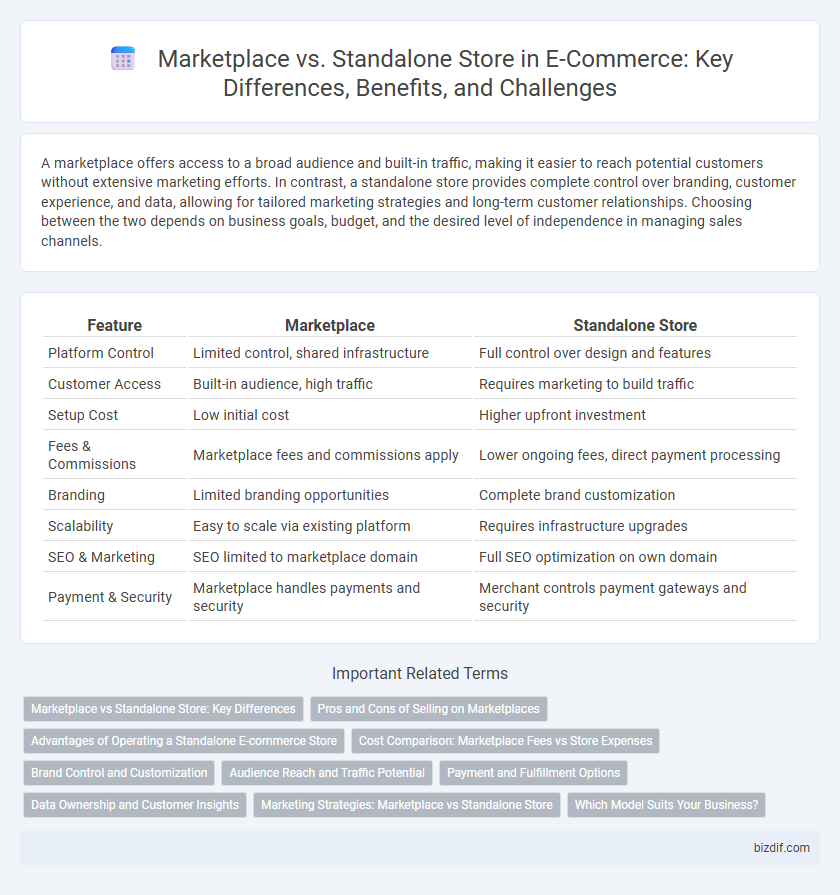A marketplace offers access to a broad audience and built-in traffic, making it easier to reach potential customers without extensive marketing efforts. In contrast, a standalone store provides complete control over branding, customer experience, and data, allowing for tailored marketing strategies and long-term customer relationships. Choosing between the two depends on business goals, budget, and the desired level of independence in managing sales channels.
Table of Comparison
| Feature | Marketplace | Standalone Store |
|---|---|---|
| Platform Control | Limited control, shared infrastructure | Full control over design and features |
| Customer Access | Built-in audience, high traffic | Requires marketing to build traffic |
| Setup Cost | Low initial cost | Higher upfront investment |
| Fees & Commissions | Marketplace fees and commissions apply | Lower ongoing fees, direct payment processing |
| Branding | Limited branding opportunities | Complete brand customization |
| Scalability | Easy to scale via existing platform | Requires infrastructure upgrades |
| SEO & Marketing | SEO limited to marketplace domain | Full SEO optimization on own domain |
| Payment & Security | Marketplace handles payments and security | Merchant controls payment gateways and security |
Marketplace vs Standalone Store: Key Differences
Marketplaces aggregate multiple sellers, offering a broad product range and built-in customer traffic, while standalone stores provide complete control over branding, customer experience, and data ownership. Marketplaces charge fees or commissions on sales, whereas standalone stores require investment in website development, marketing, and customer acquisition. The choice impacts scalability, marketing strategy, and customer relationships significantly.
Pros and Cons of Selling on Marketplaces
Selling on marketplaces offers extensive reach with millions of active buyers, reduced marketing costs, and simplified payment processing, which can accelerate sales growth for e-commerce sellers. However, marketplaces impose higher fees, limited control over branding and customer data, and increased competition from similar products, potentially lowering profit margins and weakening customer loyalty. Sellers must balance these trade-offs when deciding between marketplaces and standalone stores for their e-commerce strategy.
Advantages of Operating a Standalone E-commerce Store
Operating a standalone e-commerce store offers full control over branding, user experience, and customer data, enabling tailored marketing strategies and personalized service. Merchants avoid marketplace fees, increasing profit margins and allowing flexible pricing and promotions. Direct customer relationships foster stronger loyalty and valuable insights for continuous business growth.
Cost Comparison: Marketplace Fees vs Store Expenses
Marketplace platforms typically charge sellers fees including commissions ranging from 5% to 20%, listing fees, and transaction costs, which can significantly reduce profit margins. Standalone stores require upfront expenses such as web hosting, domain registration, payment gateway fees, and ongoing marketing costs, but avoid per-sale commissions, allowing for higher long-term profitability. Evaluating fixed costs against variable marketplace fees helps businesses decide the most cost-effective sales channel based on sales volume and budget.
Brand Control and Customization
Marketplaces offer limited brand control and customization since products are displayed alongside competitors, restricting unique brand presentation and customer experience. Standalone stores provide full control over branding elements such as website design, product display, and customer interaction, enabling a personalized shopping environment. Enhanced customization in standalone stores boosts brand recognition and customer loyalty by delivering a consistent and tailored brand experience.
Audience Reach and Traffic Potential
Marketplaces such as Amazon and eBay provide vast audience reach by aggregating millions of active buyers in one platform, enhancing product visibility through high organic traffic and established customer trust. Standalone stores rely heavily on targeted marketing strategies and SEO to drive traffic, offering complete control over branding and customer experience but typically generating lower initial volumes of visitor traffic. Businesses must evaluate their goals, as marketplaces excel in immediate large-scale exposure, while standalone stores foster long-term customer loyalty and direct engagement.
Payment and Fulfillment Options
Marketplace platforms streamline payment processing by offering integrated payment gateways, enabling quick transactions and reliable buyer protection, while standalone stores require merchants to select and manage multiple payment processors independently. Fulfillment in marketplaces often includes built-in logistics support, such as shipping partnerships and centralized order management, whereas standalone stores rely on merchants to coordinate shipping carriers and inventory tracking systems. Choosing between marketplace and standalone store affects operational complexity, with marketplaces providing simplified payment and fulfillment solutions and standalone stores offering greater customization and control.
Data Ownership and Customer Insights
Standalone stores grant businesses full data ownership, enabling comprehensive access to customer behavior, purchase patterns, and preferences, which drives personalized marketing strategies and customer retention. Marketplaces limit data access, providing aggregated or anonymized customer insights that restrict detailed analysis and direct engagement opportunities. Control over rich customer data in standalone stores supports more effective decision-making and adaptation to market trends.
Marketing Strategies: Marketplace vs Standalone Store
Marketplace platforms leverage extensive user bases and built-in traffic, enabling cost-effective marketing through sponsored ads and promotional deals, whereas standalone stores require comprehensive efforts in SEO, content marketing, and social media to drive direct traffic. Marketplaces benefit from trust signals such as reviews and brand recognition, reducing customer acquisition costs, while standalone stores must build brand authority through personalized campaigns and customer engagement strategies. Optimizing marketing strategies involves balancing marketplace visibility with standalone store branding to maximize reach and customer loyalty.
Which Model Suits Your Business?
Choosing between a marketplace and a standalone store depends on your business goals, budget, and control preferences. Marketplaces like Amazon and eBay provide instant access to a large customer base but come with fees and limited brand control. Standalone stores using platforms such as Shopify enable full customization and data ownership, making them ideal for businesses prioritizing brand identity and long-term growth.
Marketplace vs Standalone Store Infographic

 bizdif.com
bizdif.com